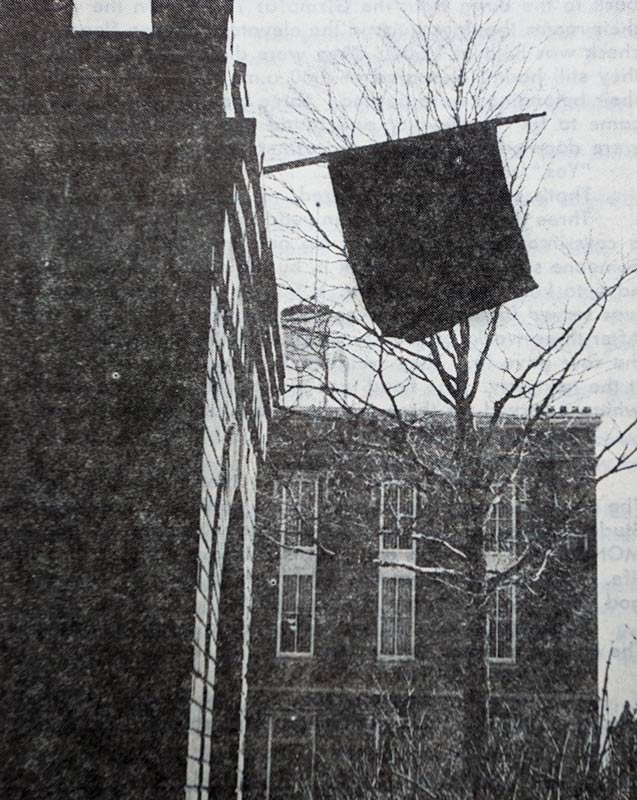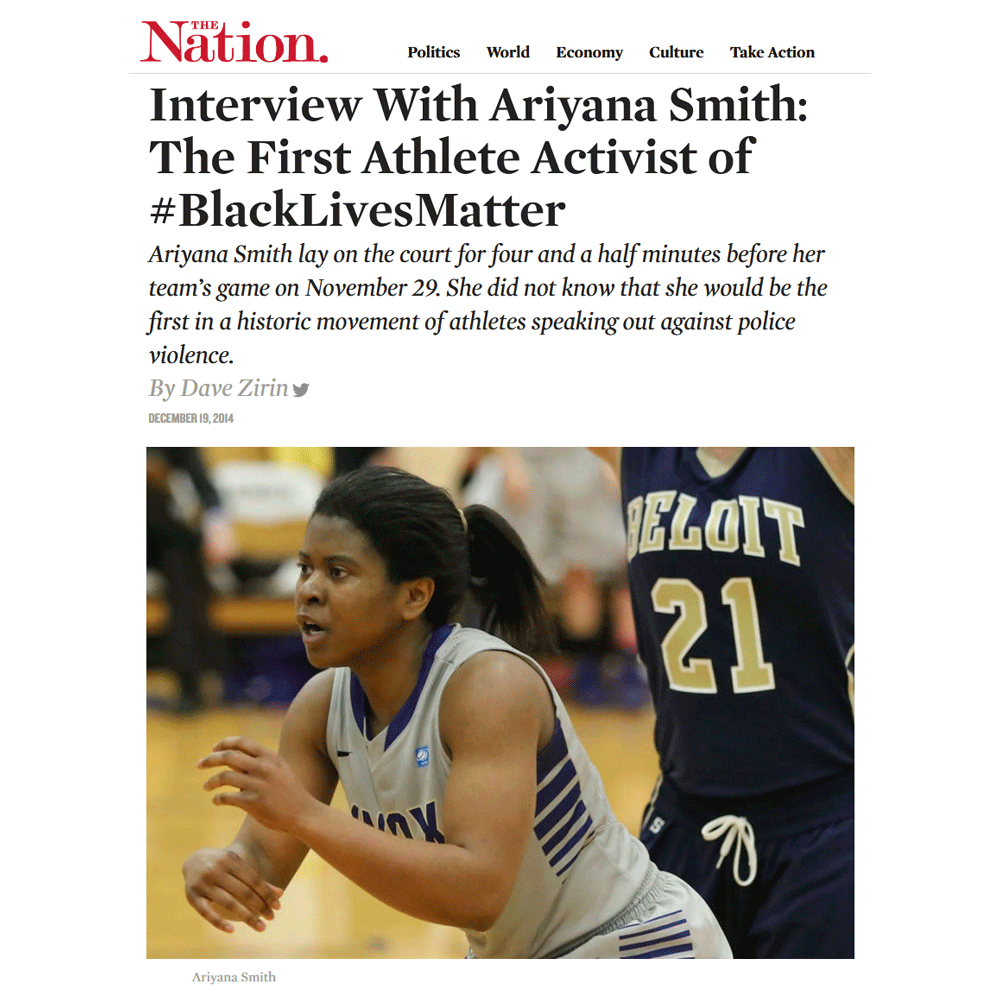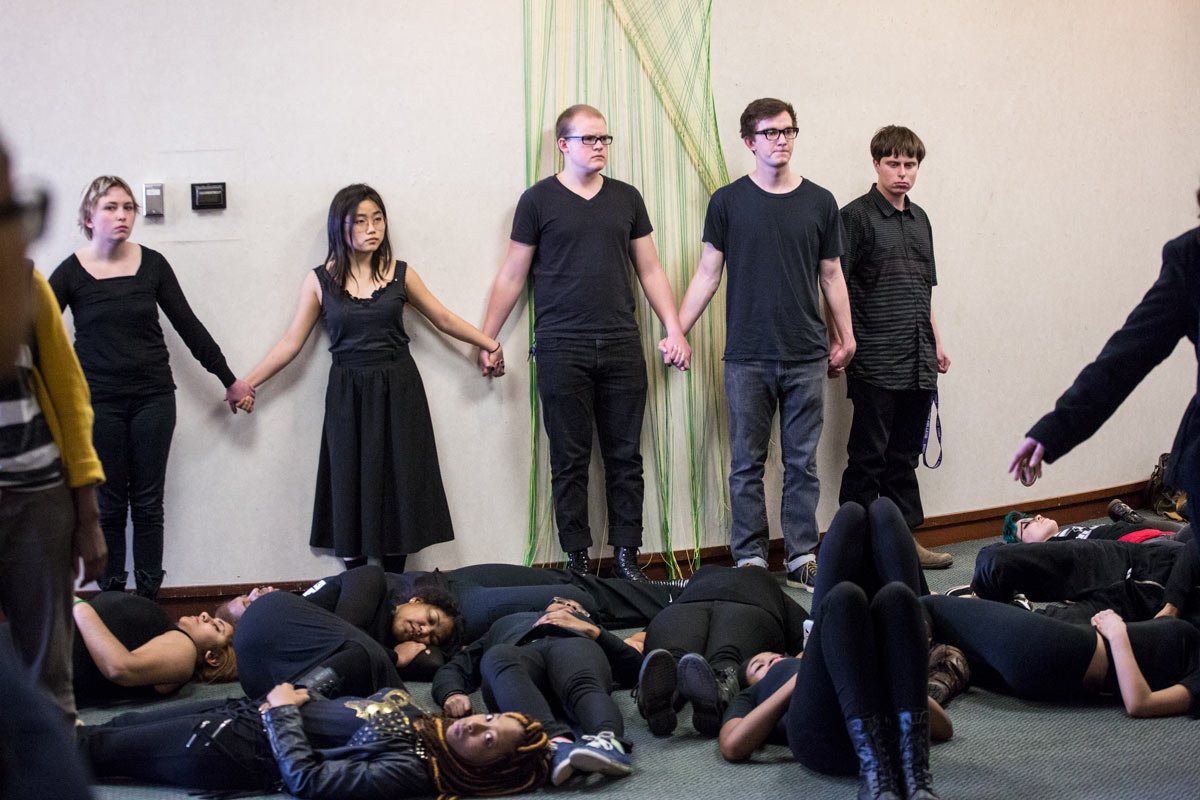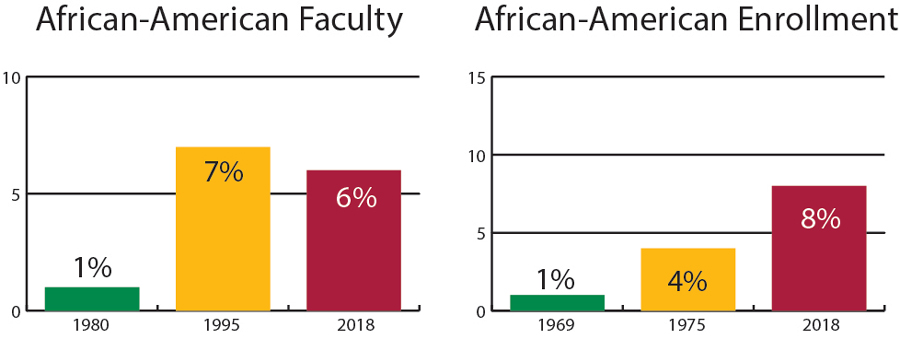The sentence “Knox College was founded by anti-slavery activists” or some variation thereof is now repeated so often in telling the history of the College, it gives the illusion that the race issue was settled on day one, and we’ve been continually progressing ever since. But continuous progress has not been the experience of Knox’s African-American students, then or now. In 1868, Knox’s first Black graduate, African native Barnabus Root, wrote that “the feeling of prejudice is almost universal in this country.” One hundred years later, in 1968–69, it was a convenient, comforting narrative of progress that African-American students challenged when they created A.B.L.E.—Allied Blacks for Liberty and Equality. Shortly after that critical year, the College’s Admission office produced a brochure written by the students who founded A.B.L.E. They wrote: “If you’re a Black student who is interested in Knox College, we’re the ones who can tell you what it’s like. We are simply ‘Tellin’ It Like It Is.’” In celebrating and chronicling A.B.L.E., tagged by an alumnus interviewed here as one of the most important student organizations in the history of the College, Knox Magazine interviewed about a dozen A.B.L.E. alumni and students from various generations, who could tell it like it was and is.
To see more images related to the story of A.B.L.E., visit "A Timeline of A.B.L.E.: 50 Years of History" under the multimedia section.
CULTURE SHOCK
Knox College prides itself on having one of the first Black graduates in Illinois. But African-American students at Knox have always found themselves in the minority and not always welcome.
If I live to be 100, I’ll never forget August of 1968. I’m in a freshman orientation group, probably 100 people, talking about race. A girl at highly prestigious Knox College stands up and says that for years and years she thought all Blacks had tails. That really shocked me. I respect [her honesty about her opinions] but I don’t understand it. [That student had] just never come in contact with any diversity whatsoever.
—Dan Taylor ’72 (read full interview)
I came from an environment that was almost 99 percent African American. Then, when you go to Knox, it’s the complete opposite. You had students from other countries, but in terms of American diversity, there was relatively little in that regard. And there were some pretty wide economic disparities. You had some very wealthy people who went to Knox. It was the first time I was exposed to that level of wealth.
—Robert Johnson ’90 (read full interview)
I remember a party at [my fraternity] FIJI and someone said “there’s too many n----s here.” And we fought, obviously. People said, “Oh he’s just making a joke.” That’s not a joke. That’s not something we’re going to let stand. No.
—Jordan Lanfair ’11 (read full interview)
Knox College is a great place. But, when I was there, it was better for some than others. Every student of color came to Knox so that they could get a great education. They felt that they were sacrificing some things socially, but it was worth it, to get this awesome education. How do we make sure that the total Knox experience is a great one for all students on campus?
—Bernard McCune ’88 (read full interview)
When the movie Boyz n the Hood came out—early ’90s, South Central LA, gang violence—I had a white guy on campus tell me, “I didn’t know you had it like that.” My reaction was, “Like what? I didn’t grow up in that type of environment.” There was this perception that you were poor, from the ghetto, and only got in because of affirmative action. Always having to be the Black voice in class, any time there was a racial component, as the Black person in the classroom, I had to speak to it.
—Esther Wilson ’99 (read full interview)
FOUNDING OF A.B.L.E.
On February 11, 1969, African- American students walked into Old Main, confronted President Sharvy Umbeck and two deans, and read out a statement: “Knox has failed through the years to provide adequate academic and social accommodations for Black students . . . A.B.L.E. has taken the problem in its own hands and has decided that our suggestions and demands should be followed despite the opposing views of our white colleagues.”

The emotional and mental state that we were in that year, there were a lot of things going on in the country—the Civil Rights movement, the Black Panthers. When Dr. King was shot, it was heartbreaking. We had nothing that we could identify with culturally at Knox College. We needed a place to go, and we needed a voice. When I went home at the end of the year, I had a whole change of mind. I came back in the fall of ’68 with an Afro and thinking “something’s gotta change.”
—Jeanne Franks ’71 (read full interview)
When I was on campus [in 2016], people asked me, “What was it like being a founder of A.B.L.E.?” I was not a founder of A.B.L.E. by any stretch of the imagination. In 1968, I was just a freshman coming into Knox, one of only three African-American freshmen that year. The groundwork had been set for A.B.L.E. by the Black students that we already had on campus. Alfreda Dortch ’69 (I would give her a lot of credit), Yvonne Brown ’70, another upperclassman, and Pat Ware ’70—they set the groundwork.
—Dan Taylor ’72
I remember walking into the president’s office and making the demands. We were afraid, but also confident that we were going to do this. We all dressed in black and walked into President Umbeck’s office, stood in a circle. One of us read the demands, and, as I recall, we walked out. President Umbeck turned so red that I thought, “Oh my God, I hope this man is not going to have a heart attack and die, right here while we’re handing him these demands!” It was one of the moments in my life that I’ll never forget.
—Jeanne Franks ’71
HOUSE & HOME
Spanning generations of students, A.B.L.E. has had a wide vision for “The House,” as the Black Cultural Center was called: In the early ’70s, A.B.L.E. students described it as a “gathering place . . . study center . . . library . . . a common place where Blacks can come and feel comfortable.” In 50 years, that hasn’t changed.

I went to A.B.L.E. House to study. There were also times that less pleasant things happened, and we gravitated toward the house as a safe haven. When Mike Brown was killed [by police in Ferguson, Missouri], the house was a place to air our frustrations that Black people keep getting killed by the police in this country. Another big rally point was when Ariyana Smith ’16 protested on the basketball court [at a Knox game being played near Ferguson]. I was the house monitor at the time, and she was my resident. When Tundun Lawani ’14 was killed [in a 2012 traffic accident], in addition to her sorority sisters, black and brown students were really grieving hard. The first place I wanted to go was to the A.B.L.E. House, because that was the place on campus where I felt safest, the most at home.
—Kathryn Todd ’15 (read full interview)
A.B.L.E. House was a home away from home that allowed African-American students like myself to let down our hair; conduct our own meetings; play our own music; sing and dance at our own parties; cook our own foods; laugh at our own jokes; and speak in our own voices as we carved out an oasis within what the late Lu Palmer (former ACM Urban Studies Professor) termed “a sea of whiteness.” We shaped our own majority space at “The House” and allowed others to enter as respected minorities who had to adjust to a different set of prevailing norms.
—Eric Z. Williams ’85 (read full interview)
My experiences in the A.B.L.E. Cultural Center were phenomenal, because of the love that Dr. Fred Hord [professor and chair of Africana Studies and founder of the Association for Black Culture Centers] provided to us students. My all-time favorite experience at the A.B.L.E. Cultural Center involved the years when the male students cooked three-course meals for the female students (and vice versa).
—Norman Golar ’02 (read full interview)
Among my responsibilities when I returned to work at Knox in the 1990s was to serve as the director of the renamed A.B.L.E. Center For Black Culture. I worked with A.B.L.E. officers, student leaders, and faculty/staff to build the new house’s library, cultural artifacts, and programming. We launched outreach efforts like the Umoja Community Gospel Choir with Jesse Dixon ’89, the A.B.L.E./Knox Math Club Tutorial Program with Jameta May ’97, African Storytelling and Poetry Workshops with Fred Hord, a Community Kwanzaa Celebration, and other cultural events.
—Eric Z. Williams ’85
We are a safe space for all students, not just Black-identifying students, who want to talk about Black culture, celebrate Black culture. We’re not just talking about issues and leaving depressed. Yesterday, we sat and colored and talked about Black talent. We’re open for campus, a space you can feel comfortable in.
—Naja Woods ’18 (read full interview)
I remember something really simple. We got everyone together and made dinner. I remember one with Maurice McDavid ’10, Christian Mahone ’11, some underclass students. We hung out and laughed and complained. That is something that’s small, but it’s not. There were nights where I had a really bad class, defending my blackness or my perspective or my history. And if I didn’t get a space where I could just let it out, I’d explode. I could go over to the house and not have to carry that. That’s what I remember the most.
—Jordan Lanfair ’11

ORGANIZING ISSUES, DEMANDS
Even after the solidification of A.B.L.E. House, significant increases in both African-American enrollment and employment, and the creation of the Africana Studies Program with two dozen courses, A.B.L.E. students and alumni feel that nothing has come easily.
One of A.B.L.E.’s roles on campus is an advocate, when things are not as they should be. One of the things that I recall vividly was that there were not many books in the library by Black authors. This was before the internet, and the library was our connection to the world. We weren’t asking for stuff that was not in step with what the College should have been doing.
—Robert Johnson ’90
During my senior year, our leadership called for a meeting with then-President John McCall. We challenged him to do more to diversify the faculty and administrative staff. We not only increased and diversified African- American student enrollment but, eventually, forged the creation of an Office of Minority Affairs and a Black Studies Program.
—Eric Z. Williams ’85
We were interested in what most students of minority descent tackled in that region of the United States—we didn’t want to be viewed as “invisible:” we wanted to have a say in student activities and that our voices would receive as much attention as the voices of other students. Off campus, we wanted to assist in “nurturing” African-American youth around Galesburg. We found ourselves inviting high school guys to campus for basketball scrimmages, inviting the youth to Knox football games where we would face-paint, and populating other student organizations that maintained after school programs.
—Norman Golar ’02
When it comes to activism, everybody’s on a different level. That’s what I like about A.B.L.E.—we have a wide range of opportunities to participate. Our daily meetings—I see that as activism, the fact that we are having a dialogue. Some people want to know more about Black students and their experiences but don’t have the opportunity to do that. And, of course, this year is A.B.L.E.’s 50th anniversary, and we’re hosting events where we’re able to talk about the Black experience.
—Nikyra Washington ’20 (read full interview)
When students took over the faculty meeting in 1988, [that showed us the importance of activism]. And Dr. Fred Hord and the Black Studies program came on campus as a result of activism. We saw it in the tragedy that happened this year [at Parkland High School] in Florida. Students have a power and a voice, and you can see that in A.B.L.E..
—Esther Wilson ’99

Our biggest issue that we raised [in a 2015 meeting with President Teresa Amott] was that as students, we are the backbone of the college, but we felt mistreated. We talked about the fact that Ariyana [Smith ’16] was suspended from the basketball team for peacefully protesting, and that was unacceptable. We had a die-in at the MLK Convocation, which was on the day of an Open House, and they guided the prospective students away from our protest. We felt like being Black on Knox’s campus, we were made the poster child for the campus, but there was not much reciprocity when it came to resources.
—Kathryn Todd ’15
One of the things about the 1960s is that the time, and the school too, promoted students speaking out. Every class, I don’t care what it was, we were debating the issues. So for us to make demands really fits what Knox College was about. Knox, in a sense, made us awake. We thought, “We’ve got some complaints, but you know what, we can do this, because this is how they do it here at Knox College.” I recognize that the negative parts are what generated those demands. But I think the other side is that Knox and the time also emboldened us.
—Jeanne Franks ’71
RESULTS, REACTIONS
A.B.L.E. alumni were asked to talk about the areas where they felt that A.B.L.E. had succeeded and the areas where they felt the struggle continues.
Allied Blacks for Liberty and Equality has stood the test of time. A.B.L.E. was not a fraternity or sorority [with the resources of a national organization behind it]. I think it’s very admirable that the incoming students over the years have kept it going and enhanced it. When the historians look at Knox College, A.B.L.E. will be high on the list of influential organizations.
—Dan Taylor ’72
Current African-American students may not realize it, but Knox is much more diverse from the time when only four of us entered as first year students in 1981. There are also tenured African-American faculty members when there were none when I was enrolled. Whether A.B.L.E. members are disrupting faculty meetings, sitting down with the Knox president over lunch to discuss change, or taking over the president’s office, the organization continues to serve as a catalyst for change and inclusion.
—Eric Z. Williams ’85

We took over a faculty meeting and presented a list of 10 demands. I felt that we had some immediate effect. One of the big issues was having a permanent A.B.L.E. House that wouldn’t be moved around. We wanted the director of minority affairs to report directly to the president of the College. We wanted targets for increasing African-American enrollment. That’s how Fred Hord got hired and the Black Studies Program was created. We had everyone’s attention, and we wanted to create some structure around it. It was not just “We’re mad,” but “we have something to contribute to an academic perspective.”
—Robert Johnson ’90
We were the class when Rick Nahm, the president, made a commitment to A.B.L.E. House as a culture center, and part of that was getting us some decent furniture. That was a great experience, because we had to get a budget, do comparison shopping. Looking back on it now, as a person with a career, I do that type of research on a regular basis, and I first did it at A.B.L.E.
—Esther Wilson ’99
I believe the administration heard us, and I believe the student government wanted to make sure that the college experience would involve all students. At the same time, I remember thinking that EVERYBODY could do better/more. Also, it helped that we had many administrative personnel of minority descent, for they understood culturally our concerns. I remember Xavier Romano, Tony Franklin, Daniel Johnson, Sheldon Davis, Cathy Walters and Marjorie Fuller [in the Office of Student Development]. I also recall the influence A.B.L.E. played on Lo Nuestro when the College recognized Casa Latina as a cultural center—this was historic because the organization didn’t have to worry about losing their “house.”
—Norman Golar ’02
We sat down with the administration when tuition was raised. I asked if they felt it would be a factor in retaining lower income students. The conversations were all for show and nothing ever came of it. But they were patting themselves on the back for trying. [If you’re a Black student struggling in class,] trying is not enough. Our administration felt that trying is enough, and that’s unfortunate.
—Kathryn Todd ’15
I think A.B.L.E. was effective. I’m not sure we were as effective as we wanted to be, because we’re still grappling with some of those same issues.
—Bernard McCune ’88
ALUMNI ADVOCATES
African-American alumni have created two organizations—the Black Alumni Association of Knox College (BAAKC) and the Black Alumni Network (BAN). BAAKC has had a Chicago focus, and BAN has taken upon itself a multi-year oral history project featuring video interviews. Both organizations have reached out to current students.
We bring a sense of maturity and our experience of being in the real world and understanding the administration’s point of view, what their mission is, and how that impacts the students. I think students can also see us as models, I would hope positive ones. They can look at us and think, “OK, look where they are, look what kind of people they are, look at their values. Look at what the experience at Knox did for them.”
—Jeanne Franks ’71
One of the reasons I stayed involved was because I wanted to give to students what I had gotten, how I had made it through. Alumni like Alfreda Williams ’69, Chris Chaney ’80, Carl Bibbs ’82, Brenda Butler ’71, Debra Banks ’73 helped me and a number of other students get through. And I got my first job out of college because of an alum, somebody who’s a member of A.B.L.E. That network of support was so important.
—Bernard McCune ’88
However ambivalent some may feel about our experience as students, we owe a measure of support to those who follow us to campus and to those who are still on campus. It’s not surprising that the most active members of BAN and BAAKC were leading officers of A.B.L.E. as students.
—Eric Z. Williams ’85
At Homecoming weekend, I got close to some alumni and they gave me very good feedback. The Black Alumni Network told us how they used to do things. Even though they’ve left, there’s still a lot of things they’d like to see A.B.L.E., and Knox as a campus, do for Black students.
—Nikyra Washington ’20
I’m very proud to be a part of BAN. But most Black alumni go through a period where they have to be far away from Knox, before they’re really able to want to make a change. There’s a feeling of not being made a priority, even though we pay tuition like everyone else. It takes time to get past that frustration before we are more likely to come back to campus and give back. So we resort to donating directly to A.B.L.E., to TRIO, to the programs that served us.
—Kathryn Todd ’15
I think it’s important for alumni to remain engaged. We have to continue reminding the students and administration of the vitality and importance of A.B.L.E. You come to realize, as you get older, that when you’re a student, you may not see the the bigger landscape of A.B.L.E., how it’s important to the campus. Once you leave campus and look back, you realize the role that A.B.L.E. played in your formation.
—Esther Wilson ’99
FUTURE FORWARD
Fifty years on, what's ahead for A.B.L.E., the College, our communities? Students and alumni were asked what they see on A.B.L.E.'s to-do list.
Because of Knox’s reputation, Knox can be a catalyst for change, in the state and nationally. Historically, when you talk about the Abolitionist movement, Knox showed that it has the passion to lead. Students and the college itself should continue to lead. Be not afraid to lead in things that are not popular, but are right.
—Bernard McCune ’88
In addition to continuing the push for more diversity and inclusion at Knox, I think that A.B.L.E. should be mentoring African-American students coming behind them, both on and off campus. A community service outreach is a must.
—Eric Z. Williams ’85
I think [A.B.L.E.’s role on campus] changes, as the interests of the student body change. It has the potential for advocacy. It also has the potential to lessen the alienation and isolation that Black students have on campus. It has the potential to be a voice in [campus] conversations. A.B.L.E. can serve as a model of an affinity house, to inspire other groups to organize and develop spaces for themselves on campus.
—Esther Wilson ’99
Working with other groups is really important. There are Afro-Latino students on campus, and A.B.L.E. is seeking to have dialogues about intersecting identities. I’d like to see more collaboration with Harambee. I know a lot of them have said that they don’t experience racism back in Africa. But when you come to America, people see you as Black.
—Naja Woods ’18

My senior year, A.B.L.E. left a time capsule in the archives in the library, to be opened in 20 years from 2015, in 2035. There are some very strong letters from students about what was happening on campus at that time. We in A.B.L.E. did it for our A.B.L.E. students of the future. That was the legacy we wanted to leave—that even though we are no longer on campus, there are people out there that care about you, that have been in your shoes and want to be contacted.
—Kathryn Todd ’15
When I was in college, I was bright eyed and bushy tailed and thought I could change the world. I hope that today’s generation still feels that way. There is still a plethora of injustices that they can look at. Whatever your gift, you owe a debt to society for the space that you occupy and the time you’ve been given. Martin Luther King said that life’s most persistent question is what are you doing for others. We often lose sight of that, while we’re pursuing our individual dreams and don’t understand that we are global citizens and are responsible for each other and to each other.
—Robert Johnson ’90
Voices of A.B.L.E.
Jeanne Franks '71 is director of marketing for Brook Architecture, Inc, of Chicago and host of "DCB Jazz" on WDCB-FM in Chicago.
Dan Taylor '72 is senior vice president at PNC Bank, Pittsburgh, in charge of 14 regional branch banks and, in 2016, was an inaugural speaker in Knox's Alumni in Residence program.
Eric Z. Williams '85 served Knox as associate dean for Intercultural Life and is currently a college and career specialist for Chicago Public Schools.
Bernard McCune '88 is chief schools officer for Blue School Partners, an educational philanthropic collaborative in Denver and recipient of a 2010 Knox Service Award.
Robert Johnson '90 is managing partner of The Solomon Group in Chicago, a consulting firm that focuses on business, management, and leadership development.
Esther Wilson '99, a public affairs specialist at the Centers for Disease Control and Prevention (CDC), is a founding member of BAN and its current president.
Norman Golar '02 is assistant professor and chair of the Department of English at Stillman College and recipient of Knox's 2012 Young Alumni Achievement Award.
Jordan Lanfair '11 was selected the 2011 Senior Class Speaker and currently teaches middle school in Chicago.
Kathryn Todd '15, selected as the 2015 Senior Class Speaker, is director of operations and Spanish interpreter at We Rock the Spectrum-Austin.
Nikyra Washington '20 and Naja Woods '18 are co-presidents of A.B.L.E. Woods has a self-designed major in Gender and Women's Studies and journalism, with a minor in Spanish. Washington is an education major with a double minor in Africana Studies and Spanish.